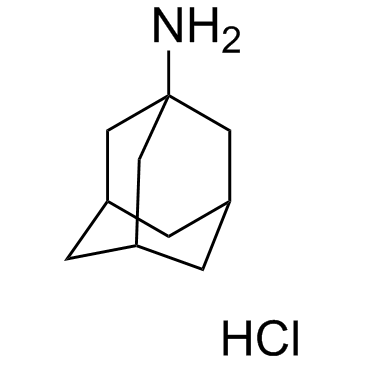1-Adamantanamine hydrochloride

1-Adamantanamine hydrochloride structure
|
Common Name | 1-Adamantanamine hydrochloride | ||
|---|---|---|---|---|
| CAS Number | 665-66-7 | Molecular Weight | 187.710 | |
| Density | 1.067g/cm3 | Boiling Point | 225.7ºC at 760 mmHg | |
| Molecular Formula | C10H18ClN | Melting Point | >300 °C(lit.) | |
| MSDS | Chinese USA | Flash Point | 96ºC | |
| Symbol |

GHS07 |
Signal Word | Warning | |
|
CDDP supramolecular micelles fabricated from adamantine terminated mPEG and β-cyclodextrin based seven-armed poly (L-glutamic acid)/CDDP complexes.
Colloids Surf. B Biointerfaces 105 , 31-6, (2013) This research is aimed to develop a nano-sized supramolecular micelle delivery system of cis-dichlorodiammine platinum (II) (CDDP) in order to achieve the passive tumor targeting. Firstly, star-shaped poly (γ-benzyl-L-glutamate) was synthesized by the ring-op... |
|
|
In vitro and in vivo identification of ABCB1 as an efflux transporter of bosutinib.
J. Hematol. Oncol. 8 , 81, (2015) Bosutinib is a recently approved ABL inhibitor. In spite of the well-documented effectiveness of BCR-ABL inhibitors in treating chronic myeloid leukemia, development of resistance is a continuous clinical challenge. Transporters that facilitate drug uptake an... |
|
|
Platinum-Incorporating Poly(N-vinylpyrrolidone)-poly(aspartic acid) Pseudoblock Copolymer Nanoparticles for Drug Delivery.
Biomacromolecules 16 , 2059-71, (2015) Cisplatin-incorporating pseudoblock copolymer nanoparticles with high drug loading efficiency (ca. 50%) were prepared built on host-guest inclusion complexation between β-cyclodextrin end-capped poly(N-vinylpyrrolidone) block and admantyl end-capped poly(aspa... |
|
|
Predicting the development of levodopa-induced dyskinesias: a presynaptic mechanism?
Neurology 82(18) , 1574-5, (2014) After chronic levodopa use, many patients with Parkinson disease (PD) develop involuntary movements. Whether disabling or minor, levodopa-induced dyskinesia (LID) constitutes an undesirable outcome calling for better treatment strategies. Options for managing... |
|
|
Simvastatin modulates cellular components in influenza A virus-infected cells.
Int. J. Mol. Med. 34(1) , 61-73, (2014) Influenza A virus is one of the most important health risks that lead to significant respiratory infections. Continuous antigenic changes and lack of promising vaccines are the reasons for the unsuccessful treatment of influenza. Statins are pleiotropic drugs... |
|
|
Interventions for fatigue in peripheral neuropathy.
Cochrane Database Syst. Rev. 12 , CD008146, (2014) Persistent feelings of fatigue (or subjective fatigue), which may be experienced in the absence of physiological factors, affect many people with peripheral neuropathy. A variety of interventions for subjective fatigue are available, but little is known about... |
|
|
A case of catatonia in a 14-year-old girl with schizophrenia treated with electroconvulsive therapy.
Z. Kinder. Jugendpsychiatr. Psychother. 41(1) , 69-74, (2013) This article presents a case of a 14-year-old female twin with schizophrenia who developed severe catatonia following treatment with olanzapine. Under a combined treatment with amantadine, electroconvulsive therapy (ECT), and (currently) ziprasidone alone she... |
|
|
Amantadine inhibits cellular proliferation and induces the apoptosis of hepatocellular cancer cells in vitro.
Int. J. Mol. Med. 36 , 904-10, (2015) Hepatocellular carcinoma (HCC) is one of the most aggressive malignancies worldwide, and its incidence associated with viral infection has increased in recent years. Amantadine is a tricyclic symmetric amine that can effectively protect against the hepatitis ... |
|
|
Application of quantitative nuclear magnetic resonance spectroscopy for the determination ofamantadine and acyclovir in plasma and pharmaceutical samples.
J. AOAC Int. 95(6) , 1644-51, (2012) Rapid, simple, and selective methods for determining amantadine HCI and acyclovir antiviral drugs in pharmaceutical and plasma samples were developed using 1H-NMR spectroscopy with dimethyl sulfoxide (DMSO-d6) as the solvent. Integrations of the 1H-NMR signal... |
|
|
In vitro interactions of amantadine hydrochloride, R-(-)-deprenyl hydrochloride and valproic acid sodium salt with antifungal agents against filamentous fungal species causing central nervous system infection.
Acta Biol. Hung. 63(4) , 490-500, (2012) The mortality rates of fungal infections that affect the central nervous system are high in consequence of the absence of effective antifungal drugs with good penetration across the blood-brain barrier and the blood-cerebrospinal fluid barrier. In the present... |